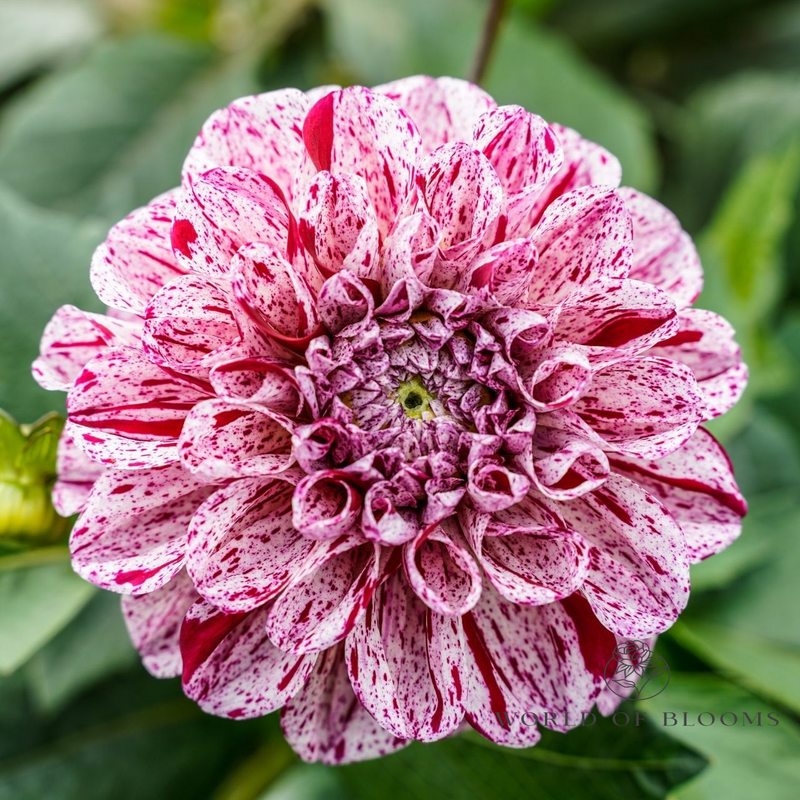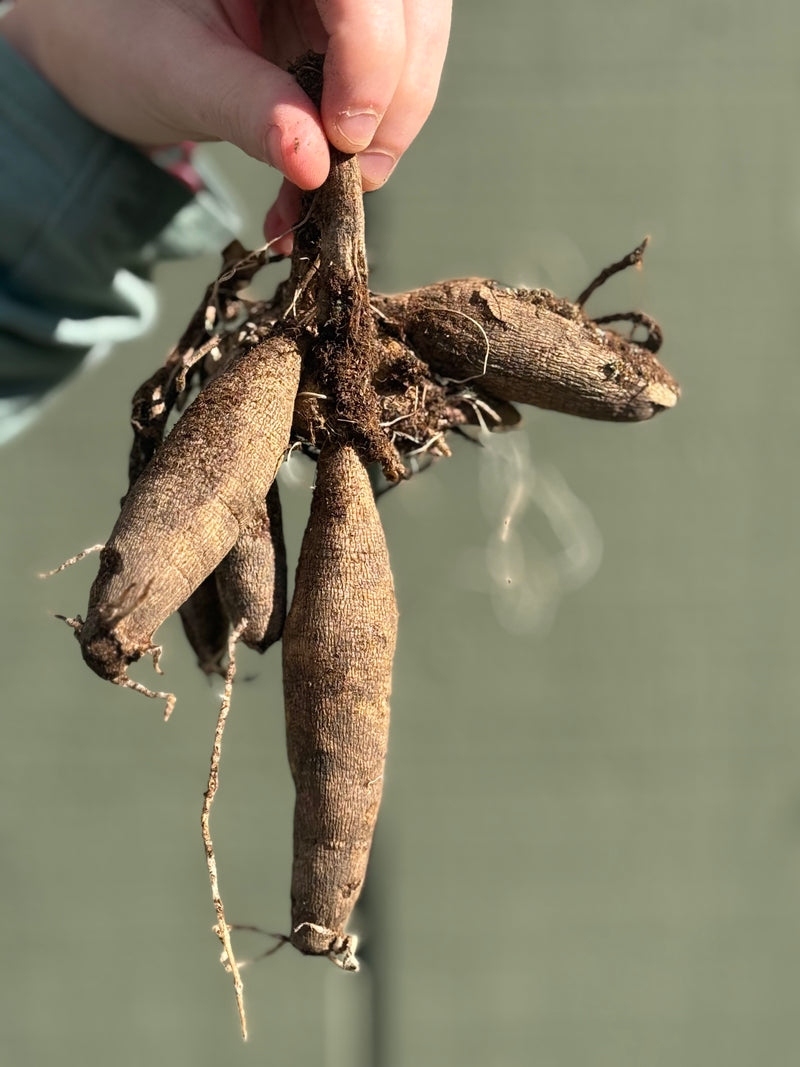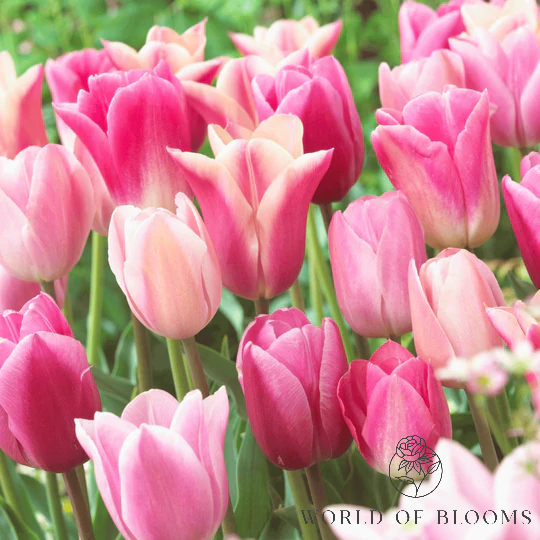Dahlia Ball 'Marble Ball'
Couldn't load pickup availability
Dahlia 'Marble Ball' is a stunning and versatile variety with its round, symmetrical blooms and distinctive two-tone color pattern. The soft white and vibrant pinkish-red hues, combined with its compact size, make it ideal for small gardens, containers, and flower beds. With proper care, including adequate sunlight, well-drained soil, and occasional staking, this dahlia will reward gardeners with a long period of captivating blooms. Whether used in landscaping, as a cut flower, or as part of a garden display, 'Marble Ball' is sure to make a lasting impression.
Zones: 3 - 11
General Characteristics:
- Flower Type: Ball-shaped dahlia
- Bloom Size: The blooms of Marble Ball are medium to large in size, typically around 4 to 6 inches (10–15 cm) in diameter.
- Flower Form: Like all ball dahlias, the flowers of Marble Ball are spherical and full, with petals that are tightly packed and curved inward. This creates a dense, rounded shape that makes them highly ornamental and visually appealing.
Petal Color and Pattern:
- Main Color: Marble Ball has a unique color pattern that sets it apart from other dahlias. The petals are primarily white, but each petal has soft, subtle streaks of deep pink or red, creating a marbled effect.
- Pattern: The marbled streaks in the petals appear like veins or subtle brushstrokes of color, giving each flower an almost painted or marble-like appearance. The result is an eye-catching contrast of clean white with splashes of pink or red, which varies slightly from flower to flower.
- Color Variations: The exact amount of pink or red streaking can vary depending on growing conditions, but it tends to be most pronounced in cooler weather, making the flowers even more striking.
Foliage:
- Leaves: The foliage of Marble Ball is deep green, which creates a lovely contrast to the bright and intricate blooms. The leaves are narrow, long, and somewhat serrated, contributing to the plant’s overall lush appearance.
Growth Habit:
- Height: Marble Ball is a relatively compact and upright variety of dahlia, typically growing to about 3 to 4 feet (90 to 120 cm) tall. This makes it suitable for mid- to back-of-the-border positions in the garden.
- Spread: The plant has a moderate spread, with its branches growing in a bushy and branching habit. This compact form helps support the large, rounded blooms without the need for excessive staking.
- Stem: The stems of Marble Ball are strong and sturdy, which allows them to support the heavy flowers, though in particularly windy conditions or with very tall plants, some light staking may be beneficial.
Growing Conditions:
- Sunlight: Marble Ball dahlias thrive in full sun. They need at least 6 to 8 hours of direct sunlight per day to grow strong and produce abundant blooms.
- Soil: Dahlias, including Marble Ball, prefer well-drained, fertile soil with a slightly acidic to neutral pH (6.0 to 7.0). The soil should be rich in organic matter, such as compost or well-rotted manure, to encourage healthy root development and vibrant blooms.
- Watering: Consistent watering is important for dahlias, especially during dry periods. The soil should remain moist but not waterlogged, as too much moisture can cause root rot. However, dahlias are relatively drought-tolerant once established.
Flowering Season:
- Bloom Time: Marble Ball produces flowers from mid-summer until the first frost. This makes it an excellent late-season bloomer that continues to provide vibrant color when many other plants start to fade.
- Flowering Duration: The plants can continue to bloom for several weeks, especially if spent flowers are deadheaded regularly, encouraging the plant to produce more buds.
Unique Features:
- Distinctive Color Pattern: The most striking feature of Marble Ball is its marbled petal pattern. The mix of white and deep pink or red streaks makes it an excellent choice for adding contrast and visual interest to any garden or floral arrangement.
- Cut Flowers: Marble Ball is an excellent cut flower due to its long-lasting blooms and unique color pattern. The spherical shape and striking contrast make it a favorite for bouquets and arrangements. To get the best cut flowers, harvest them in the early morning or evening when they are fresh and place them in water immediately.
Hardiness:
- USDA Hardiness Zones: Marble Ball dahlias are generally hardy in USDA zones 8 to 10, which means they thrive in regions with mild winters. In colder climates (zones 7 and below), the tubers need to be dug up and stored over the winter to prevent frost damage. They can be replanted in the spring after the last frost.
Planting Instructions
1. Choosing the Right Location
Dahlias require specific growing conditions to thrive, so selecting the right spot is key:
- Sunlight: Dahlias love full sun. Choose a location that receives at least 6-8 hours of direct sunlight each day. The more sun they get, the better the blooming.
- Soil: Well-drained, fertile soil is essential. Dahlias do best in slightly acidic to neutral soil (pH 6.0 to 7.0). If your soil is heavy clay or drains poorly, amend it with organic matter (like compost) to improve drainage and fertility.
- Protection from Wind: Although dahlias are relatively tall and sturdy, they can be vulnerable to strong winds. Plant them in a sheltered spot to prevent breakage or damage to the flowers.
2. When to Plant Dahlias
Dahlias are warm-season flowers and should be planted once the threat of frost has passed and the soil has warmed up. In most regions, this means planting them in late spring, typically around late April to early May, after the last frost date.
- Soil Temperature: The ideal soil temperature for planting dahlia tubers is around 60°F (15°C). If the soil is too cold, the tubers may rot before they have a chance to sprout.
3. Preparing the Soil
Good soil preparation helps dahlias grow strong and healthy:
- Amend the Soil: Before planting, work compost or well-rotted manure into the soil. This adds nutrients and helps with drainage.
- Loosen the Soil: Dahlias have tubers that need to spread out, so make sure the soil is loose, not compacted.
- Add Fertilizer: Mix a slow-release balanced fertilizer or one specifically designed for flowering plants into the soil before planting to give your dahlias a nutrient boost.
4. Planting the Tubers
Once the soil is prepared, it's time to plant your dahlia tubers.
- Spacing: Dahlias should be spaced about 18-24 inches (45-60 cm) apart, depending on the variety. Taller varieties may need more space, while compact varieties can be planted a bit closer together.
- Planting Depth: Dig a hole or trench around 6 inches (15 cm) deep. Place the tuber in the hole with the "eyes" (small, bud-like protrusions) facing upward. If you’re planting multiple tubers, make sure there is enough room for the tubers to spread out as they grow.
- Orientation: If the tuber has a noticeable direction (like a flat side), plant it so that the eyes are facing upward. If unsure, it’s fine to plant the tuber sideways or with the flat side facing down.
- Covering: Gently cover the tuber with soil, and water it well after planting. Avoid burying the tuber too deeply; about 6 inches is ideal. The soil should be loose enough to allow the tuber to sprout easily.
5. Watering and Mulching
- Watering: After planting, water the area thoroughly to settle the soil around the tuber. Keep the soil evenly moist, but not soggy, while the tubers are establishing themselves. Once the plants start growing, they need consistent moisture, especially during dry spells.
- Mulching: Apply a thin layer of mulch around the plants to help retain moisture and suppress weeds. Organic mulch like straw, leaves, or grass clippings works well. However, avoid placing mulch directly on the tubers.
6. Staking or Supporting Dahlias
Dahlias can grow tall, especially larger varieties, so they may need support:
- Staking: To prevent the stems from flopping over, you can insert stakes near the plants and tie the stems loosely to the stakes. This is especially important for tall varieties or those with large flowers.
- Cages: Another option is to use a wire cage around the plant to provide support as it grows. This keeps the plant upright and the flowers undamaged by wind or rain.
7. Fertilizing and Care During the Growing Season
Once your dahlias are planted, it’s important to feed and care for them as they grow:
- Fertilizing: After planting, you can give dahlias a light dose of a high-phosphorus fertilizer to encourage blooming. Later in the growing season, switch to a balanced fertilizer or one that is lower in nitrogen. Over-fertilizing with too much nitrogen can result in lush foliage but fewer flowers.
- Deadheading: Remove spent blooms regularly to encourage new flowers and keep the plant looking tidy.
- Pruning: Prune the stems lightly to encourage branching. If you're growing large varieties, you may want to pinch off the top few buds to encourage bushier growth.
8. Aftercare and Harvesting
- Watering: Ensure that dahlias receive regular watering throughout the growing season, especially when the weather is hot and dry. The soil should stay moist but not waterlogged.
- Cutting Flowers: Dahlias are wonderful cut flowers! If you want to enjoy them indoors, cut them in the early morning or evening when they’re freshest, and place them in water immediately.
9. Overwintering Dahlias (for cold climates)
- Digging Up Tubers: In colder climates (zones 7 and below), you’ll need to dig up dahlia tubers before the first frost hits. Carefully lift the tubers with a spade or fork, being careful not to damage them. Trim the foliage and let the tubers dry for a couple of days in a cool, dry place.
- Storage: After drying, store the tubers in a cool, frost-free location, like a basement or garage, in a box with peat moss, sawdust, or sand to keep them dry. Check on the tubers periodically to make sure they haven’t rotted.




Recently viewed






